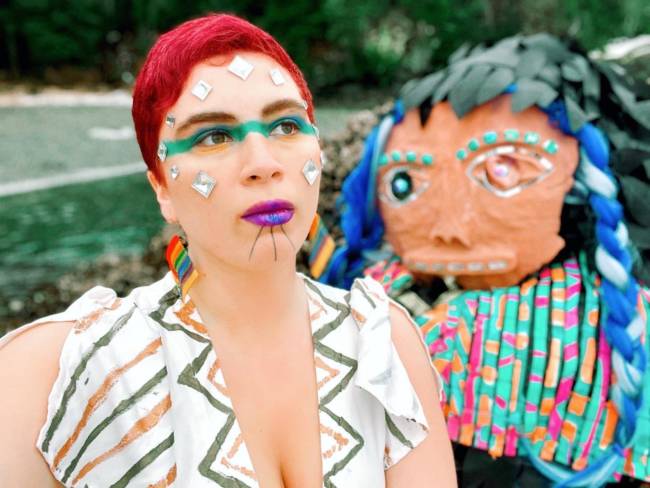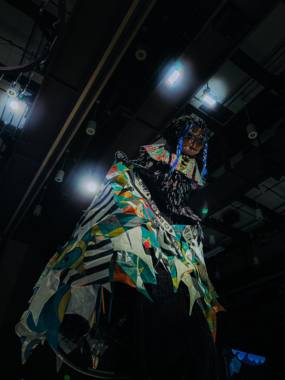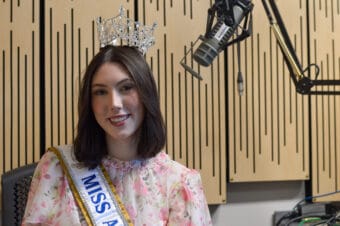
This year’s Wearable Arts entries had many themes, from climate awareness to the joys of Juneau to shrimp cocktail. K̲aachgóon Rochelle Smallwood’s piece stood out.
Titled Ya Héen Áwé Ya K̲usteeyi, it towered over the audience, standing more than 10 feet tall on the model, Magdalena Kahlo. The title of K̲aachgóon’s piece, its description and the music behind it are all in Lingít.
Every year during Wearable Arts, professional judges come in and weigh each piece and its presentation — then they pick their favorites. But K̲aachgóon’s piece got left out of that process.

She found out that her piece had been disqualified from judging. The Juneau Arts and Humanities Council management, which puts on the show, says this was because of a miscommunication and a time crunch. They made assumptions about whether K̲aachgóon wanted her piece to be judged.
The model who wore the piece, Kahlo, as well as other artists and models at the event, complained of racism and exclusion backstage. The complaints worked their way up the chain to Nancy DeCherney, the JAHC’s Executive Director. The council apologized for the miscommunication, and its board members say they held two meetings to discuss the complaints.
Juneau arts council staff determined that there wasn’t racism involved in the decision to exclude K̲aachgóon’s piece from the judging process, but Kahlo disagrees.
“For them to just be like, ‘No, it wasn’t racist.’ It was like — it’s just kind of like — okay, well, you don’t get to decide that,” she said.
Kahlo says her experience during the weekend of Wearable Arts included microaggressions from other competitors and uncomfortable reactions to the piece being entirely in Lingít. K̲aachgóon wasn’t able to attend the event in person, but Kahlo says when she told event staff that the piece would be entirely in Lingít,“they were like ‘Yeah, haha, like that’s funny. Like, how is that going to happen?’ They laughed about it to my face.”
Council Board President Abel Ryan, who is Tsimshian, says the JAHC was initially hesitant about the piece being in Lingít.
DeCherney said it opened up larger conversations about the Lingít language here in Juneau.
“The message that is there because it’s entirely in Lingít, to Lingít speakers is one message. But to those of us who haven’t learned to speak Lingít, and we’ve lived here forever, that’s another message we should hear,” she said.
That was part of K̲aachgóon’s goal with the piece. To her, it was essential that none of the Lingít she used for the piece be translated into English.
“Native artists don’t have to explain their art or their Indigeneity for people — we don’t have to digest it for them,” she said. “And I feel like a lot of times, we’re asked to perform Native for consumption, and that we’re expected to act a certain way and explain it a certain way. And I’m hoping to help change that narrative. And I’m also hoping to normalize getting the language back on the land.”
As Lingít language revitalization efforts grow, University of Alaska Southeast language professor X̱’unei Lance Twitchell says that the question — to translate or not to translate — is coming up more often.
“And you know, maybe if you’re not connected to someone in the language learning community, maybe it’s time that you make that connection,” he said. “That way you have someone you can ask or hopefully spark some curiosity to just learn a few things.”
He also says it’s important to consider our expectations for art to be made for English speakers. That expectation can impact people whose languages have been violently suppressed.
“I understand that some people want to know, and they feel excluded if they don’t know,” Twitchell said. “But then hopefully, there’s got to be ways, I think, for the communities to also sort of say, ‘Hey, not everything has to be for everybody.’ But at the same time, it does get complicated at times, because some people were dealing with languages that were specifically prohibited by an English speaking population. And so there is just a weird dynamic when when we say, ‘Hey, you need to translate this for the English speaking population, that also came here and has nearly killed your language.’”
Kaagwaantaan community member, author and poet Ernestine Hayes says she wasn’t surprised to hear about K̲aachgóon’s experience trying to make art in Juneau and display it during Wearable Arts. She says this is common for Indigenous artists and Lingít people — that they have to change everything about themselves to be considered acceptable or qualified.
“You know, you can do some research on art, if we see a painting that we don’t understand or by an artist that we’re not familiar with, we don’t dismiss it and reject it immediately. We do some research, we talk to people, we ask questions, and then we appreciate it even more,” she said.
She brought up an incident from 2018 when a Japanese geisha-inspired costume at Wearable Arts prompted complaints about cultural appropriation and was later pulled from the lineup.
Hayes says art is meant to challenge your perspective, to help you grow.
“We’re all taught to see everything through a white lens and removing ourselves from that takes dedication and constant attention, but it’s difficult to remain aware because that white lens keeps pulling us back,” she said.
Going forward, the Juneau Arts and Humanities Council management say they’re considering removing the judging process from Wearable Arts.
K̲aachgóon’s piece was in the running for this year’s people’s choice award — that went to Georgia Post’s piece “To Know Water.”
Correction and editor’s note: An earlier version of this story misspelled Tsimshian and Nancy DeCherney’s name. The story has been updated to include the winner of the people’s choice award. Some of the information in this story has been rearranged for clarity.
KTOO has a media sponsorship agreement with the Juneau Arts and Humanities Council and was a sponsor of Wearable Art. Additionally, KTOO’s Membership and Marketing Manager sits on the JAHC Board of Trustees.



